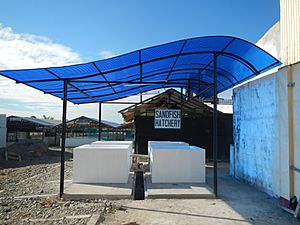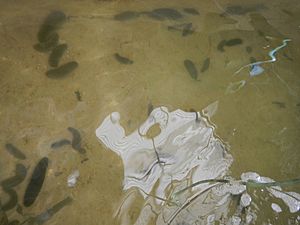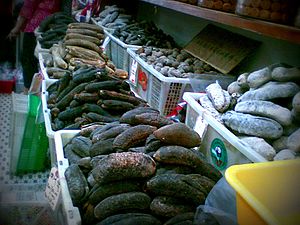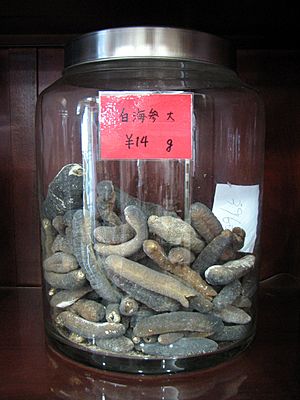Sea cucumber as food facts for kids
Sea cucumbers are amazing sea animals that belong to a group called Holothuroidea. People eat them fresh or dried in many different foods around the world. In some cultures, people even believe sea cucumbers can be good for your health!
These interesting creatures are known by many names. In French, they're called bêche-de-mer, which means "sea animal." In Indonesia, they're trepang, and in Japan, they're namako. In the Philippines, they're balatan, and in Hawaii, loli. In Malaysia, they're known as gamat.
Many cultures in East and Southeast Asia think sea cucumbers are a special food. They have a unique, slippery texture when cooked. People often cook them with ingredients like winter melon, dried scallops (conpoy), kai-lan, shiitake mushrooms, and Chinese cabbage.
Sadly, many types of sea cucumbers are now in danger. This is because too many are being caught for food. It's important to protect them so they don't disappear from our oceans.
Contents
How Are Sea Cucumbers Harvested?
Sea cucumbers that are caught for food are usually gathered by hand. This is done from small boats, and the process is called "trepanging". This name comes from the Indonesian word trepang. After they are caught, sea cucumbers are often dried to keep them fresh for a long time. Before cooking, they need to be soaked and boiled in water for several days to become soft again. They are mostly used in soups or stews, especially in Chinese cooking.
Many important types of sea cucumbers are caught and dried. They are then sent to other countries for use in Chinese cuisine, where they are called 海参 (hǎishēn). Some common types you might find in markets include:
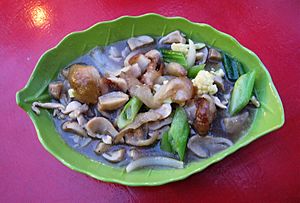
- Holothuria scabra (sandfish)
- Holothuria fuscogilva (white teatfish)
- Holothuria nobilis (black teatfish)
- Apostichopus japonicus (Japanese sea cucumber)
- Parastichopus californicus (giant California sea cucumber)
- Thelenota ananas (prickly redfish)
In Western Australia, people fish for sea cucumbers from Exmouth all the way to the Northern Territory border. Most of what they catch is sandfish (Holothuria scabra). Fishing for these "bêche-de-mer" species is controlled by special laws.
Other types of sea cucumbers caught in Western Australia include Holothuria nobilis (black teatfish) and Thelenota ananas (prickly redfish). In northern Queensland, Australia, sea cucumbers are caught from the Great Barrier Reef. Divers go deep, up to 40 meters, to collect them by hand.
The Sea Cucumber Market
The trade of trepang between sailors from Macassar and the Aboriginal people of Arnhem Land was the first time people from Australia traded with their Asian neighbors.
The market for sea cucumbers in Asia is worth a lot of money, about US$60 million each year. Most of the sea cucumbers traded (95%) are in their dried form. They are sold in countries like China, Singapore, Malaysia, Korea, and Japan.
Sea cucumbers are mainly used in Chinese cuisine. The biggest places that re-export them are Mainland China, Hong Kong, and Singapore. There are about 650 different kinds of sea cucumbers, but only 10 of them are valuable for trade. In 2013, the Chinese government made rules to stop officials from buying expensive sea cucumbers. This was because their high price could look like a sign of too much luxury.
In Japan, people also eat sea cucumber raw, like sashimi. They also eat its intestines, which are salted and fermented. This dish is called konowata. The dried ovary of the sea cucumber is also eaten and is called konoko or kuchiko.
Cooking with Sea Cucumbers
Both fresh and dried sea cucumbers are used in cooking. However, preparing them can be tricky because they don't have much taste on their own. In an old Chinese cooking book from the Qing Dynasty called Suiyuan shidan, it says: "Sea cucumbers have no taste, are full of sand, and smell fishy. Because of this, they are the hardest ingredient to prepare well."
A lot of the work in preparing sea cucumbers involves cleaning and boiling them. Then, they are often cooked in rich meat broths to give them flavor. This way, each sea cucumber soaks up the delicious taste of the broth.
Images for kids
-
Braised sea cucumber with mushrooms, pork, and tea eggs
See also
 In Spanish: Pepino de mar (gastronomía) para niños
In Spanish: Pepino de mar (gastronomía) para niños



